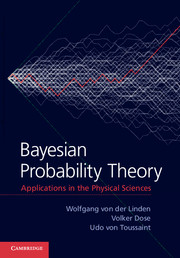Book contents
- Frontmatter
- Contents
- Preface
- PART I INTRODUCTION
- PART II ASSIGNING PROBABILITIES
- PART III PARAMETER ESTIMATION
- PART IV TESTING HYPOTHESES
- PART V REAL-WORLD APPLICATIONS
- 21 Regression
- 22 Consistent inference on inconsistent data
- 23 Unrecognized signal contributions
- 24 Change point problems
- 25 Function estimation
- 26 Integral equations
- 27 Model selection
- 28 Bayesian experimental design
- PART VI PROBABILISTIC NUMERICAL TECHNIQUES
- Appendix A Mathematical compendium
- Appendix B Selected proofs and derivations
- Appendix C Symbols and notation
- References
- Index
22 - Consistent inference on inconsistent data
from PART V - REAL-WORLD APPLICATIONS
Published online by Cambridge University Press: 05 July 2014
- Frontmatter
- Contents
- Preface
- PART I INTRODUCTION
- PART II ASSIGNING PROBABILITIES
- PART III PARAMETER ESTIMATION
- PART IV TESTING HYPOTHESES
- PART V REAL-WORLD APPLICATIONS
- 21 Regression
- 22 Consistent inference on inconsistent data
- 23 Unrecognized signal contributions
- 24 Change point problems
- 25 Function estimation
- 26 Integral equations
- 27 Model selection
- 28 Bayesian experimental design
- PART VI PROBABILISTIC NUMERICAL TECHNIQUES
- Appendix A Mathematical compendium
- Appendix B Selected proofs and derivations
- Appendix C Symbols and notation
- References
- Index
Summary
It is common experience of all experimental scientists that repeated measurements of supposedly one and the same quantity result occasionally in data which are in striking disagreement with all others. Such data are usually called outliers. There are numerous conceivable reasons for such outliers. Formally we may consider the sequence of measurements dj with confidence limits dj ± σj. If the distance ∣dj – dk∣ of any two data points dj and dk becomes larger than the sum (σ2k + σ2j)1/2 of the associated errors, then the data start to become inconsistent and finally at least one of them will become an outlier. There are no strict meanings to the terms ‘inconsistent’ and ‘outliers’ and it is exactly this lack of uniqueness in the definition which enforces a treatment by probability theory. We shall consider two different cases. Inconsistency of the data may result from a wrong estimate of the measurement error σk. Already Carl Friedrich Gauss was concerned about measurement uncertainties and stated that ‘the variances of the measurements are practically never known exactly’ [81]. Inconsistency may also arise from measurements distorted by signals from some unrecognized spurious source, leading to ‘strong’ deviations of dk from the mainstream. We shall begin with the first case.
Erroneously measured uncertainties
In the preceding sections we have boldly assumed that the standard deviation σi of the error distribution for the measured quantity di is known exactly. This assumption almost never applies.
- Type
- Chapter
- Information
- Bayesian Probability TheoryApplications in the Physical Sciences, pp. 364 - 395Publisher: Cambridge University PressPrint publication year: 2014

